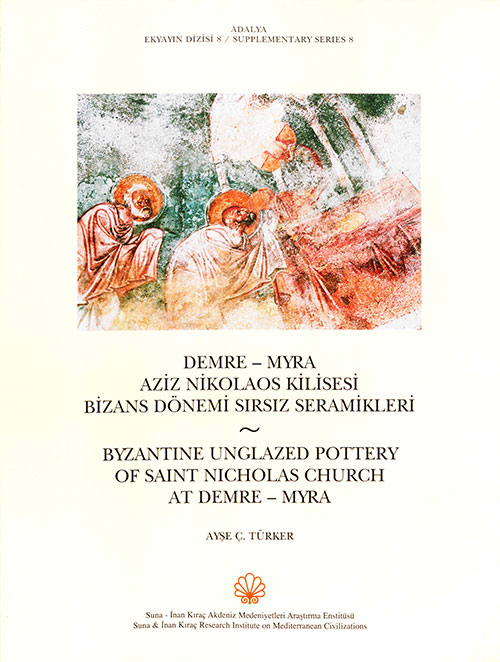
| Author | Ayşe Ç. Türker |
| Editor | Kayhan Dörtlük – Tarkan Kahya |
| Material Type | Book |
| Year | Antalya, 2009 |
| ISBN No | 978-6054018-06-2 |
| Dimensions | 210×280 mm |
| Page | 228 pages |
| Figure | 131 Figures |
| Language | in Turkish and in English |
| Translation | T.M.P. Duggan – İnci Türkoğlu |
| Series | Adalya Supplementary Series 8 |
Summary
Excavations at the Church of St. Nicholas at Demre-Myra, the metropolis of Lycia, present us with archaeological material that permits us to follow the historical development of the region from the 5th century through to the end of the 14th century. Unglazed pottery constitutes the largest group of material finds and unglazed pottery is also the largest and the most common group of survey and archaeological finds. In spite of this unglazed pottery is usually omitted from the scope of most excavation. To get the construction of past with the whole aspects as much as possible is the aim of a systematic excavation. According to this, not being evaluated of the unglazed seramics can be an important problem. In the culture of a community, the materials meet the nourishment need have basic function. Therefore these finds can be an important find group providing that we could reach the daily life and the datas we follow the changing of this life in period. The numerical majority of unglazed ceramics can give important datas about being understood of systems of productionconsumption
and shopping.
Publications that include the unglazed pottery from Lycia provide us with information only up until the 7th century; consequently only a small portion of the finds from Demre can be compared with contemporary material from elsewhere in the region. Publication of the unglazed pottery finds from the on-going excavations at Limyra and Xanthos consist of preliminary excavation reports. The surveys at Kyaneai, Dereağzı, Alahan, Karacaören and the Gemiler Island at Ölüdeniz have culminated in a ceramic publication. However, these are catalogue-type studies which mainly document only surface finds.
Beyond Lycia, the first publication to include unglazed pottery came from Tarsus Gözlü Kule. This was followed by publications on the finds from Korucutepe, Aşvan Kale, Anamur, Sardes, Saraçhane, Perge, Ephesus, Gritille, Sagalassos and Kinet. The Sagalassos work is a doctoral thesis, including unglazed pottery dating at the latest from the 7th century and presents parallel examples that are comparable with only a small group of the Demre finds. This same situation is valid also for the Tarsus, Anamur, Sardes and Ephesos17 publications, which present us with only a small number of examples. Examples contemporary with the Demre finds come from Saraçhane and Perge. In the medieval strata of the mound-type settlements in south-eastern Anatolia there are pottery examples that have been dated to the same period as Demre finds. Thus, it is possible to state that unglazed Byzantine pottery has not been taken as fully into consideration in the publications as it should have been and in consequence there is a significant absence of published information in this field. That’s why It has been aimed to evaluate in many ways 35.000 ceramic pieces which were carried out in the excavations of Demre- Myra St. Nicholas Church. It has been foreseen that the datawhich will be got after the works for this aim will provide an imporntant help to the lack of knowledge in this field and the solution to these problems which were made up of that.
